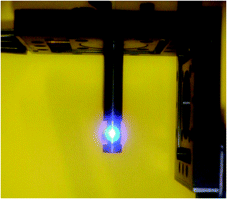Abstract of Publication No. 473
 Karl W. Krämer, Daniel Biner, Gabriela Frei, Hans U. Güdel, Markus P. Hehlen and Stefan R. Lüthi
Karl W. Krämer, Daniel Biner, Gabriela Frei, Hans U. Güdel, Markus P. Hehlen and Stefan R. Lüthi
Hexagonal Sodium Yttrium Fluoride Based Green and Blue Emitting Upconversion Phosphors
Chem. Mater. 16, 1244-1251 (2004)
![]()
![]()
Abstract:
Hexagonal sodium yttrium fluoride, NaYF4, is the most efficient host
material to date for green (Yb3+/Er3+ doped) and blue
(Yb3+/Tm3+ doped) upconversion (UC) phosphors, i.e.,
phosphors which emit visible light upon infrared (IR) excitation. The structure
of the hexagonal phase gives rise to controversy about the cation sites and
distribution. The X-ray diffraction patterns of our phosphors do not fit well
with the crystal structure reported for NaNdF4 (space group
P![]() , Z = 1.5). The Na:M
ratio (M = Y, Nd, Er, Tm, Yb) of the hexagonal phase deviates significantly from
1:1, and it depends on M and the preparation temperature. It is proposed that
the hexagonal phase is isostructural to the chlorides
Na3xM2-xCl6
with M = La-Sm. This structure (space group P63/m,
Z = 1) contains only one M3+ site which is partially occupied
by Na+, and the formula
Na3xM2-xF6
(x
, Z = 1.5). The Na:M
ratio (M = Y, Nd, Er, Tm, Yb) of the hexagonal phase deviates significantly from
1:1, and it depends on M and the preparation temperature. It is proposed that
the hexagonal phase is isostructural to the chlorides
Na3xM2-xCl6
with M = La-Sm. This structure (space group P63/m,
Z = 1) contains only one M3+ site which is partially occupied
by Na+, and the formula
Na3xM2-xF6
(x ![]() 0.45) accounts for the
nonstoichiometry. The model was derived from powder X-ray diffraction on the
green and blue phosphor materials as well as the pure Nd, Y, and Yb compounds.
The light emission properties of the material crucially depend on the phase
purity, doping ratio, Na:M ratio, and preparation temperature. Because earlier
spectroscopic investigations generally suffered from impure materials which
reduced the UC efficiency, a new, reproducible preparation route was developed.
Its key features are an excess of NaF in the synthesis, i.e., a 2:1 ratio of
Na:M, the use of HF gas for fluorination, and a process temperature lower than
the melting point of the respective NaF/MF3 eutecticum. It yields the
pure hexagonal phase without admixture of the cubic phase or other impurities
except for minor inclusions of NaF. Upon IR excitation at 10 245
cm–1, the samples doped with 18% Yb + 2% Er and 25% Yb +
0.3% Tm showed the highest UC efficiencies for green and blue emission,
respectively. Relative UC efficiencies were measured with a powder test setup in
a standard procedure. The doping ratios and all steps of the synthesis were
optimized with respect to the UC efficiency. The obtained phosphor materials
show no degradation under high-power IR laser excitation.
0.45) accounts for the
nonstoichiometry. The model was derived from powder X-ray diffraction on the
green and blue phosphor materials as well as the pure Nd, Y, and Yb compounds.
The light emission properties of the material crucially depend on the phase
purity, doping ratio, Na:M ratio, and preparation temperature. Because earlier
spectroscopic investigations generally suffered from impure materials which
reduced the UC efficiency, a new, reproducible preparation route was developed.
Its key features are an excess of NaF in the synthesis, i.e., a 2:1 ratio of
Na:M, the use of HF gas for fluorination, and a process temperature lower than
the melting point of the respective NaF/MF3 eutecticum. It yields the
pure hexagonal phase without admixture of the cubic phase or other impurities
except for minor inclusions of NaF. Upon IR excitation at 10 245
cm–1, the samples doped with 18% Yb + 2% Er and 25% Yb +
0.3% Tm showed the highest UC efficiencies for green and blue emission,
respectively. Relative UC efficiencies were measured with a powder test setup in
a standard procedure. The doping ratios and all steps of the synthesis were
optimized with respect to the UC efficiency. The obtained phosphor materials
show no degradation under high-power IR laser excitation.